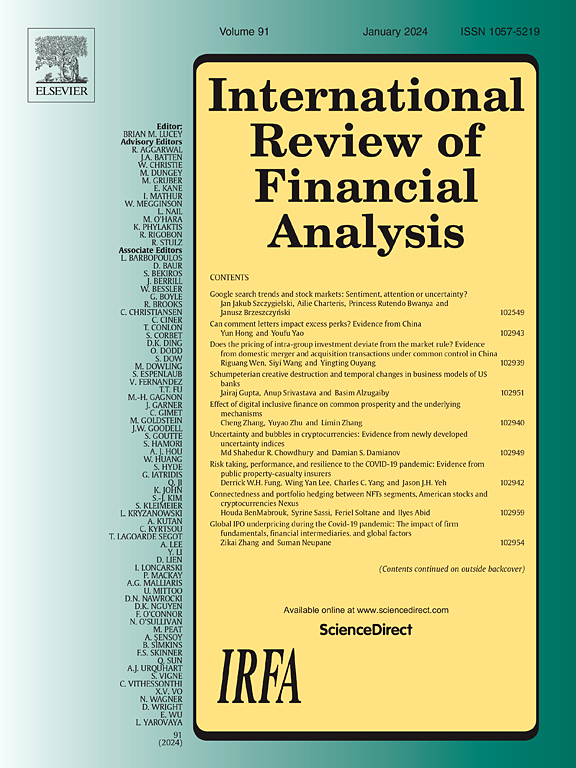能源加密货币与美国股市之间的关联性:基于量值的分析
IF 7.5
1区 经济学
Q1 BUSINESS, FINANCE
引用次数: 0
摘要
能源加密货币是一类新的数字资产,具有道德良知的投资者可以利用它建立具有高风险调整回报的长期投资组合。本研究以这一独特的资产类别为重点,研究了能源加密货币与美国股票行业股票之间在不同量级的静态和动态溢出效应。我们对 2018 年 2 月 27 日至 2022 年 11 月 25 日的四种能源加密货币和 11 个主要美国股票市场的选定样本应用了量化 VAR 技术。这一时期包括两个重要的子时期:COVID-19 和俄乌战争。我们的研究结果表明,与平均量值和中位量值相比,极端低量值和高量值的关联度水平更高。虽然所有能源加密货币在极端低量化点都是冲击接收器,但大多数美国股票在低量化点都是冲击发射器。信息技术行业在所有量级上都是冲击接收器,而能源行业则是冲击发射器。整体关联度随时间波动,并在 COVID 期初显著上升。我们的研究结果为投资者、投资组合经理和政策制定者在市场下行和上行时进行投资组合分配、预测和风险管理提供了启示。此外,理想对冲比率在 COVID-19 大流行期间略有上升,这增加了资产覆盖的成本。本文章由计算机程序翻译,如有差异,请以英文原文为准。
Connectedness between energy cryptocurrencies and US equity markets: A quantile-based analysis
Energy cryptocurrencies emerge as a new class of digital assets for morally conscientious investors to build long-term portfolios with high risk-adjusted returns. Focusing on this unique asset class, the current study investigates the static and dynamic spillovers between energy cryptocurrencies and US equity sector stocks at various quantiles. We apply the quantile VAR technique on the selected sample of four energy cryptocutrrencies and eleven major US equity markets for February 27, 2018 to November 25, 2022. This period includes two important subperiods: COVID-19 and the Russian-Ukraine War. Our findings support higher connectedness levels at the extreme lower and upper quantiles compared to the mean and median quantiles. While all energy cryptocurrencies are shock receivers at the extreme lower quantile, the majority of US equity sector stocks are shock transmitters at the lower quantile. The IT sector is a shock receiver at all quantiles, whereas the energy sector is a shock transmitter. Overall connectedness fluctuates over time and shows a significant rise at the start of the COVID period. Our results provide insights to investors, portfolio managers, and policymakers regarding portfolio allocation, forecasting, and risk management during downward and upward market conditions. Additionally, the ideal hedge ratios slightly increased during the COVID-19 pandemic, which increased the cost of asset coverage.
求助全文
通过发布文献求助,成功后即可免费获取论文全文。
去求助
来源期刊

International Review of Financial Analysis
BUSINESS, FINANCE-
CiteScore
10.30
自引率
9.80%
发文量
366
期刊介绍:
The International Review of Financial Analysis (IRFA) is an impartial refereed journal designed to serve as a platform for high-quality financial research. It welcomes a diverse range of financial research topics and maintains an unbiased selection process. While not limited to U.S.-centric subjects, IRFA, as its title suggests, is open to valuable research contributions from around the world.
 求助内容:
求助内容: 应助结果提醒方式:
应助结果提醒方式:


